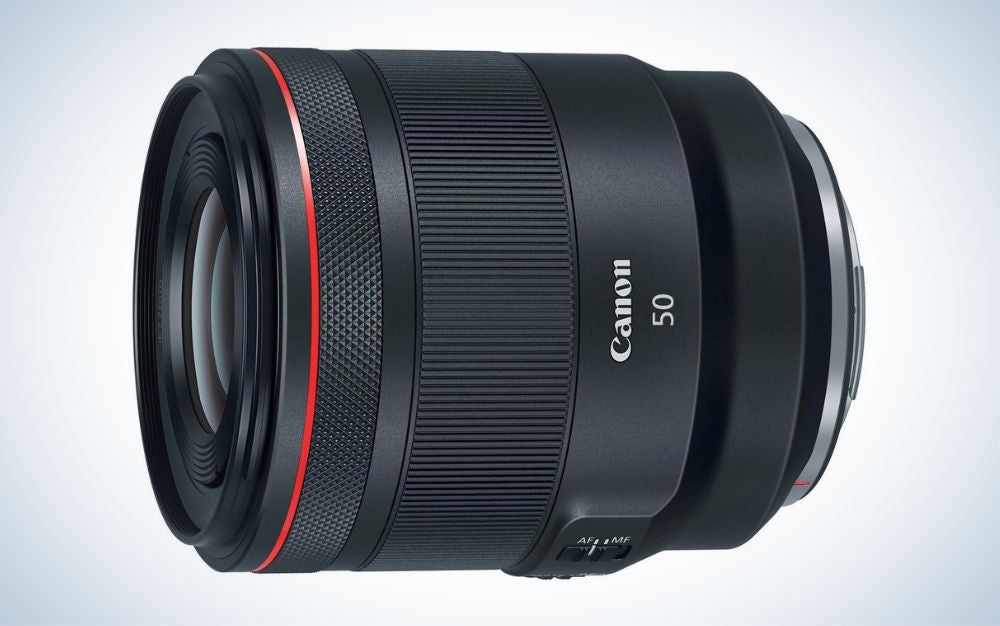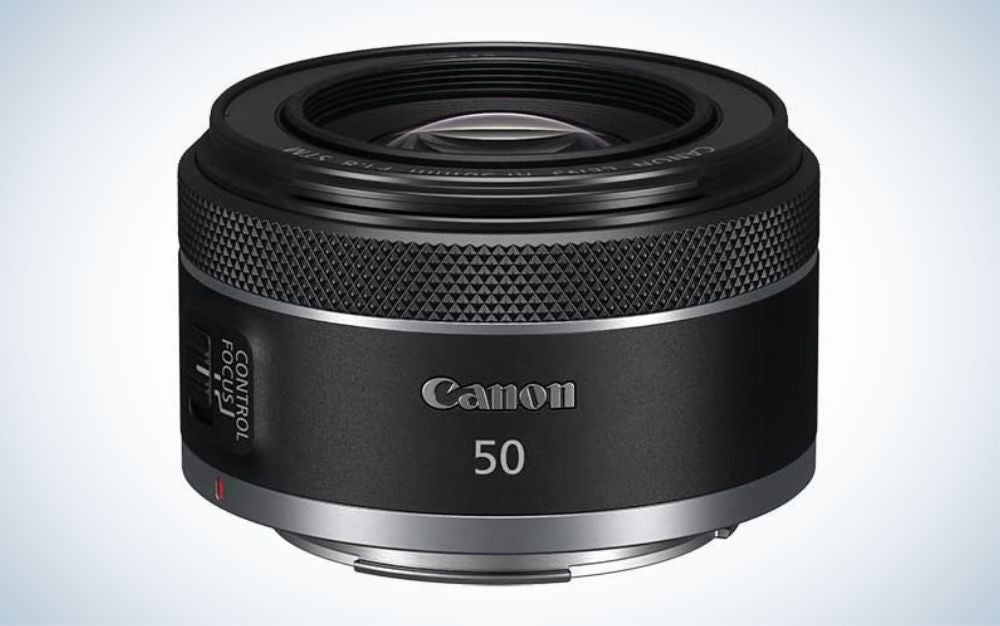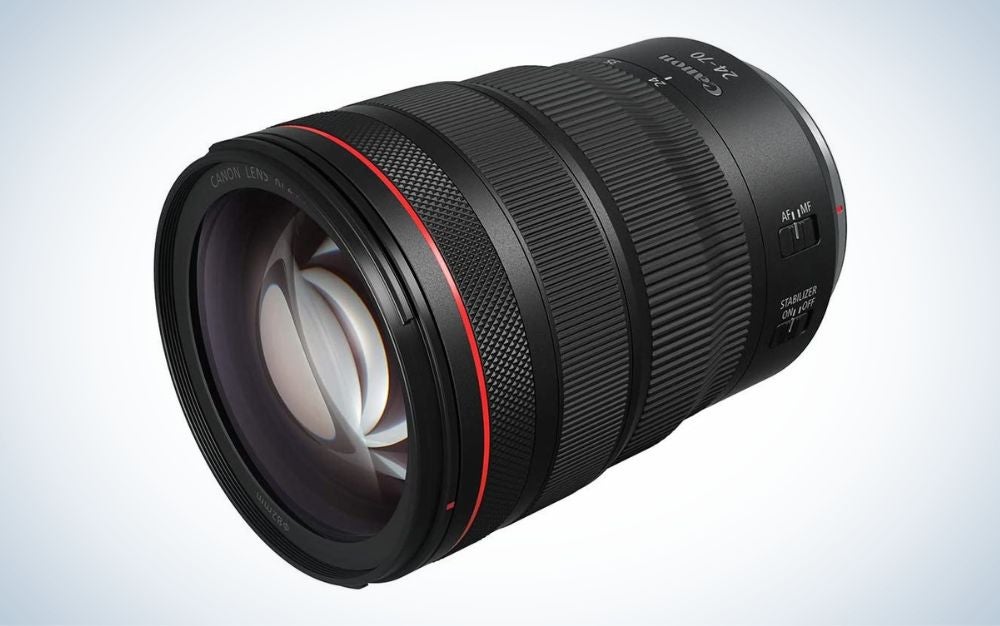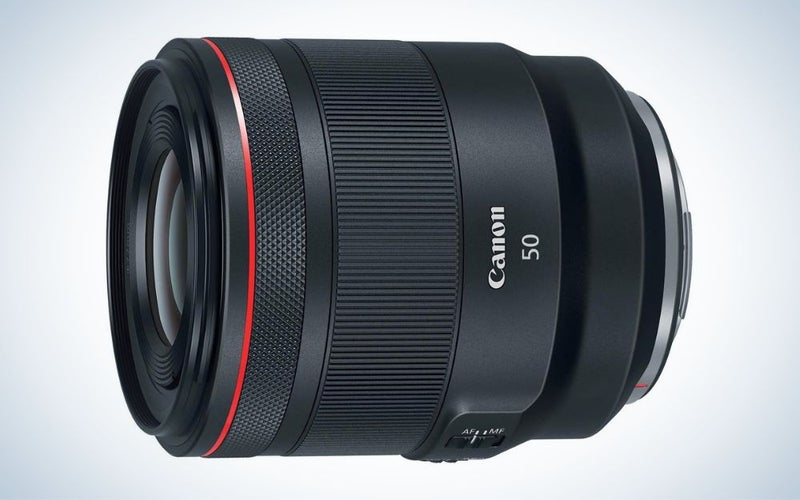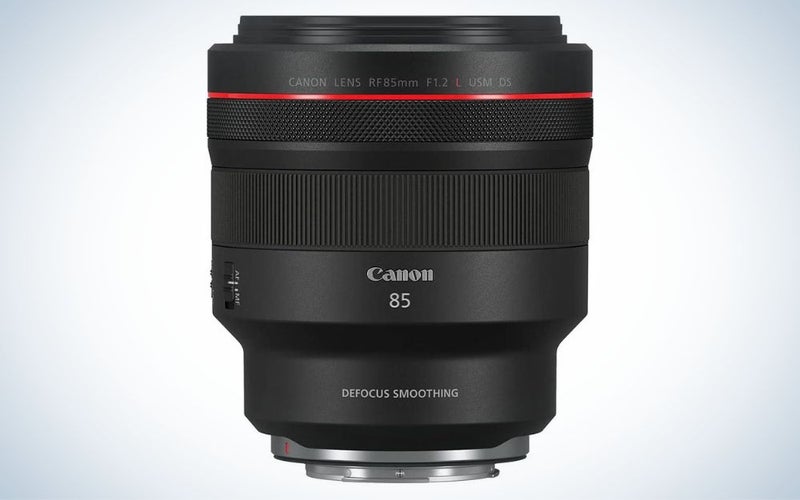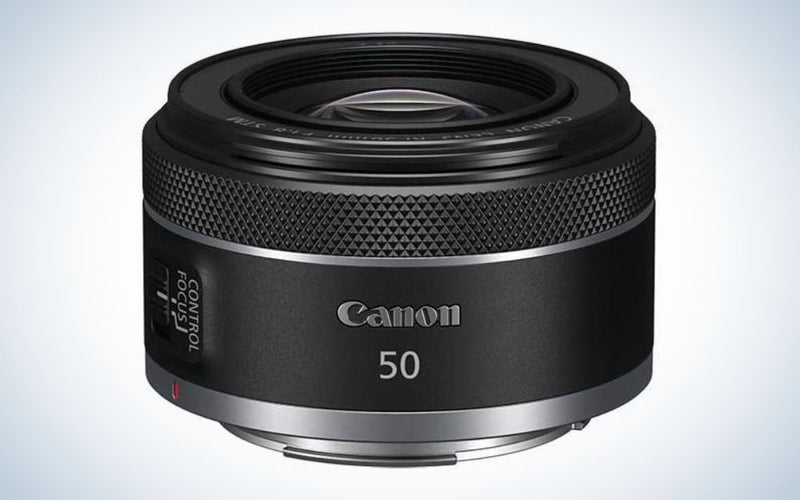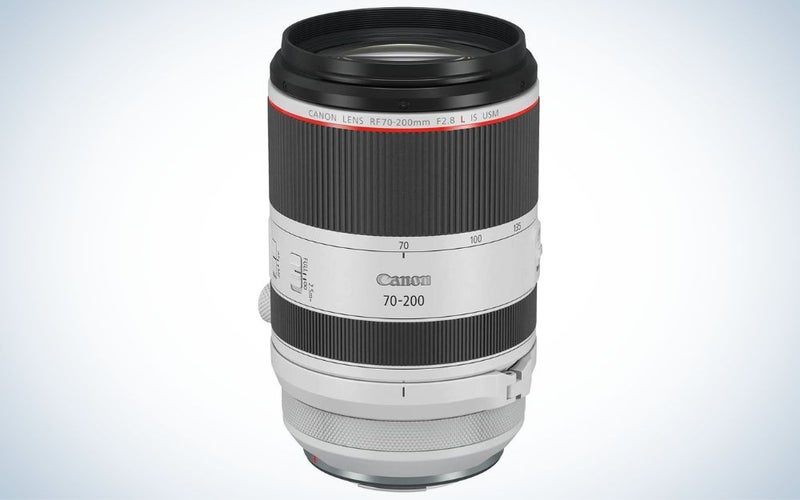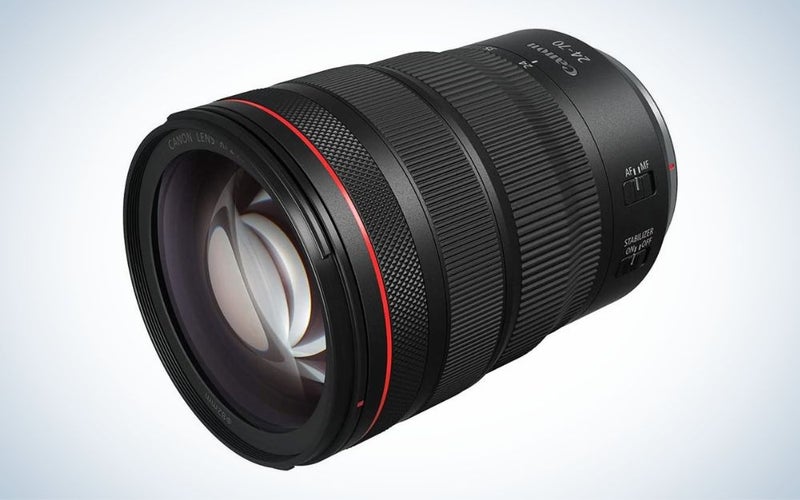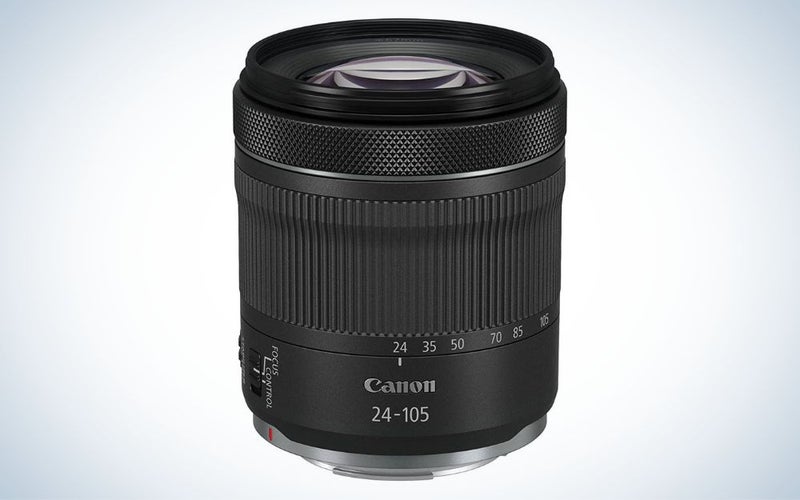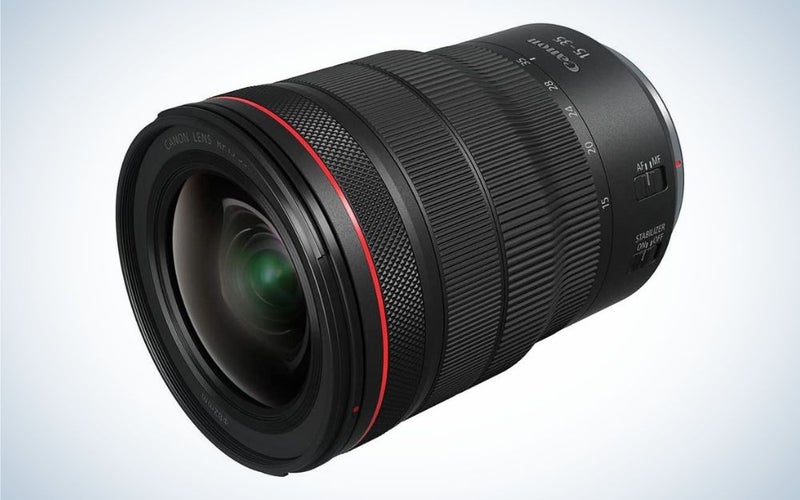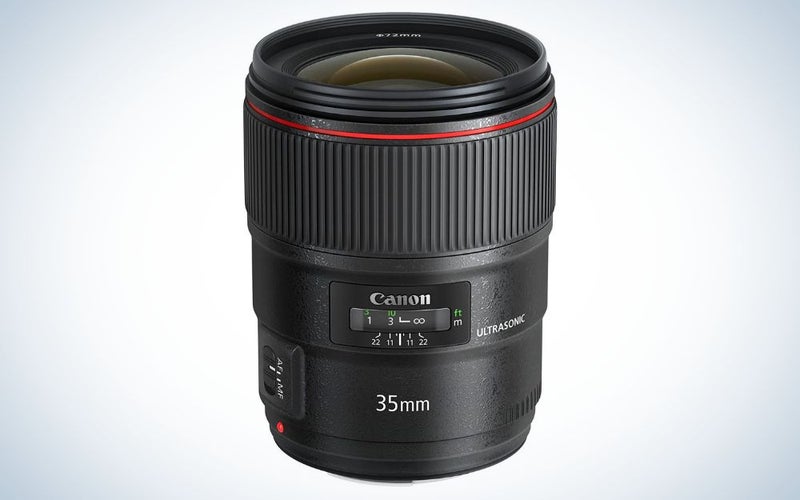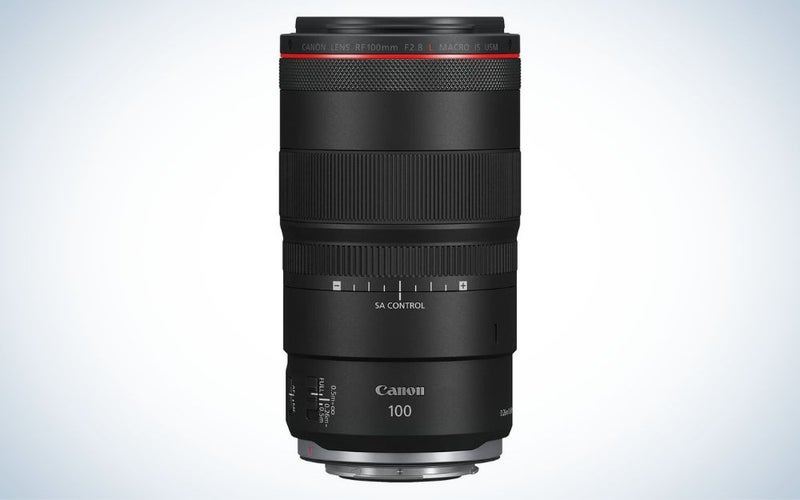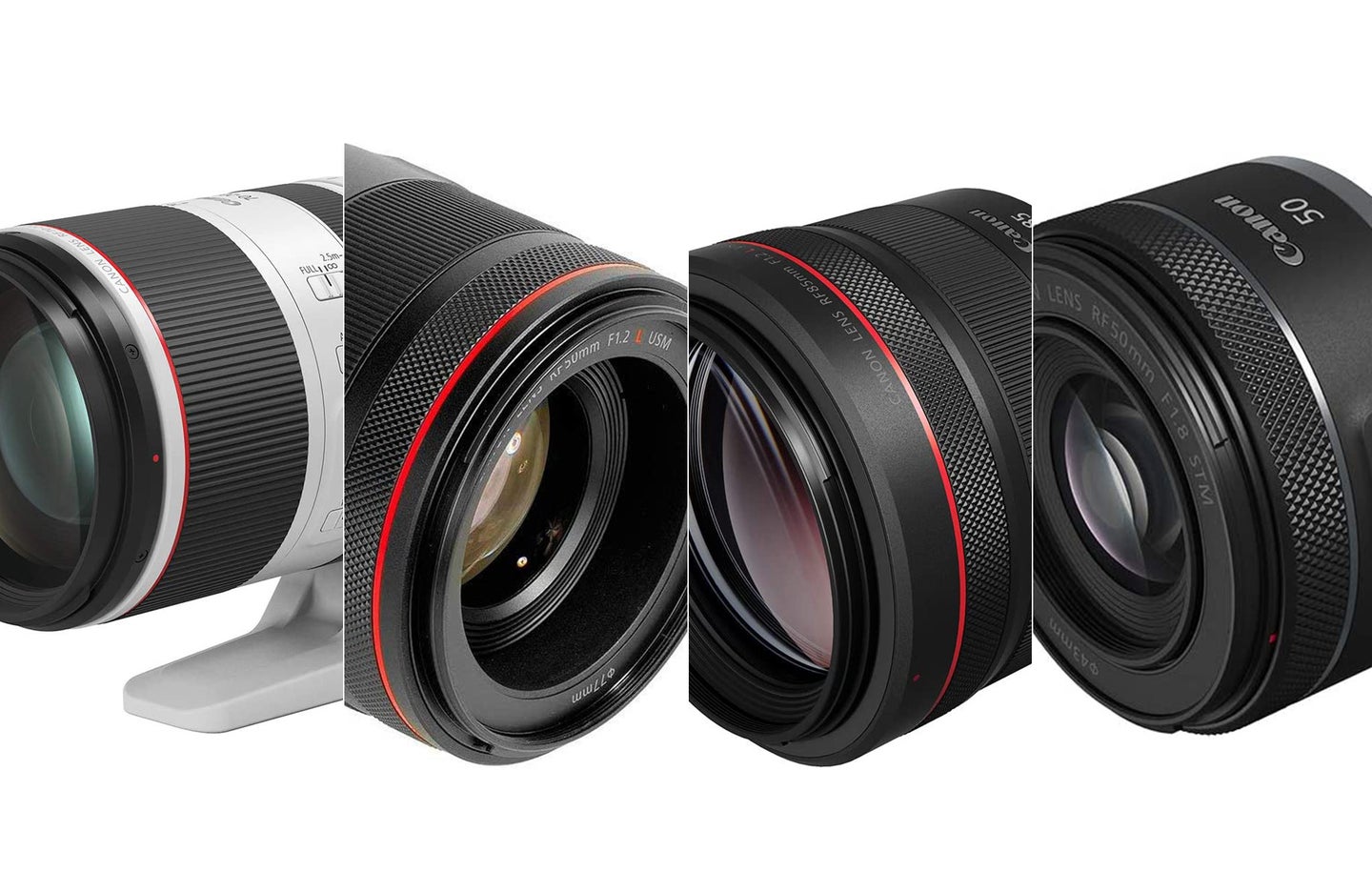
We may earn revenue from the products available on this page and participate in affiliate programs. Learn more ›
There are a lot of Canon lenses in the world. In 2021, the company announced that it had manufactured more than 150 million EF and RF lenses for its DSLRs and mirrorless cameras. With that kind of prolific output over several different lines, it can be challenging to hunt down the Canon lens that best suits your shooting style (and your budget). Fortunately, this list of the best Canon lenses will help you find exactly what you’re looking for.
- Best overall: RF 50mm F1.2 L USM
- Best for portraits (high-end prime): RF 85mm F1.2 L USM DS
- Best for portraits (budget prime): RF 50mm F1.8 STM
- Best for portraits (high-end zoom): RF 70-200mm F2.8 L IS USM
- Best standard zoom (high-end): RF 24-70mm F2.8 L IS USM
- Best standard zoom (budget): RF 24-105mm F4-7.1 IS STM
- Best wide-angle (high-end zoom): RF 15-35mm F2.8 L IS USM
- Best wide-angle (high-end prime): EF 35mm f/1.4L II USM
- Best wide-angle (budget prime): EF 40mm f/2.8 STM
- Best telephoto zoom (budget): RF 100-400mm F5.6-8 IS USM
- Best macro: RF 100mm F2.8 L MACRO IS USM
How we picked the best Canon lenses
I have been writing about, reviewing, and using cameras as a professional photographer for nearly two decades. I have shot Canon gear as my personal kit for the majority of that time and have personally reviewed or at least shot with just about every lens on this list.
To find the best Canon lenses, I have broken some categories up into high-end and budget options because the price differences can be huge. While Canon doesn’t really make any truly bad lenses (at least at the moment), this list prioritizes models that offer exceptional image quality and durability.
You’ll also notice that almost every lens on the list relies on the Canon RF mount, which is native to its R-series mirrorless cameras. While there are still plenty of excellent EF-mount DSLR lenses out there, the RF glass represents the present and future of the company’s offerings. I’ll mention some older EF options along the way, which can be great if you have DSLRs you still want to use or you’re just looking to save some cash.
The best Canon lenses: Reviews & recommendations
Best overall: RF50mm F1.2 L USM
Canon
Why it made the cut: Canon put a ton of engineering into its flagship standard prime. The result: A lens with immaculate sharpness, beautiful rendition, and almost zero distortion.
Specs:
- Focal length: 50mm
- Maximum aperture: f/1.2
- Minimum aperture: f/16
- Image stabilization: No
- Elements: 15 elements in 9 groups
- Filter size: 77mm
- Dimensions: 3.54 x 4.25 in., approx. 2.09 lbs
- Weight: 33 ounces
Pros:
- Almost no distortion
- Extremely sharp, even when shooting wide open
- Solid build with weatherproofing
- New coatings fight flare
- Beautiful bokeh
Cons:
- Expensive
- Big and heavy compared to older versions
Canon built this flagship 50mm prime lens to show off what its full-frame R-series cameras can do. It’s not just one of the best Canon lenses. It’s easily one of the best modern lenses I have ever used.
50mm lenses aren’t particularly prone to distortion, but you’ll find almost none in this lens. It focuses quickly, quietly, and accurately. While you will notice some vignetting when shooting wide open, it’s not overpowering and can even work in your favor if you’re shooting portraits or trying to isolate a subject. As you stop the lens down, the vignette disappears, and it’s sharp and bright across the entire frame.
Canon’s new Air Sphere coating promises to fight flare and aberration. In my experience, it does a fantastic job. Even in very high-contrast areas, the lens keeps unwanted effects to a bare minimum.
All that performance does come with costs, however. At $2,299, it’s a very expensive lens. It’s also considerably longer and heavier than the previous EF version. But, while it’s not exactly compact or light, it doesn’t feel overly heavy or humongous when attached to a full-frame body.
Yes, this lens is an investment, but it’s also a benchmark offered by the company to maximize its cameras’ capabilities. That’s worth the cost if you can swing it.
Best for portraits (high-end prime): RF85mm F1.2 L USM DS
Canon
Why it made the cut: This classic focal length offers a special coating that smooths out bokeh for more pleasing backgrounds.
Specs:
- Focal length: 85mm
- Maximum aperture: f/1.2
- Image stabilization: No
- Elements: 13 elements in 9 groups
- Filter size: 82mm
- Dimensions: 4.62 x 4.06 inches
- Weight: 42 ounces
Pros:
- Unbeatable bokeh thanks to its fast aperture and DS coating
- Very sharp
- Built-in control ring in addition to the focus ring
Cons:
- Big
- Expensive
Fast 85mm lenses have been a staple for portrait photographers for decades. The short telephoto focal length masterfully avoids perspective and optical distortion while keeping the subject at a comfortable working distance that doesn’t feel too intimate or removed from the process. Canon’s flagship 85mm f/1.2 lens costs more than most of the cameras in its lineup, but it delivers unmatched image quality in this space.
Like the 50mm f/1.2, it’s absurdly sharp, even when shooting wide open. One of the big challenges when shooting with it is to not go overboard shooting at f/1.2. The depth of field is so shallow that it can look otherworldly or dreamy. The DS in its name stands for Defocus Smoothing. An additional coating makes out-of-focus highlights in the frame appear softer and more subtle, which makes them less likely to distract viewers from the image’s subject.
The body includes a function ring in addition to the focus ring, and the whole thing is weatherproof in line with Canon’s L-series lens specs. Again, this is a big, heavy lens, but it provides an aesthetic and image quality that you won’t get with anything else.
Best for portraits (budget prime): RF50mm F1.8 STM
Canon
Why it made the cut: The nifty fifty provides a fast aperture and a standard angle of view which works well for loose portraits. It’s also very cheap.
Specs:
- Focal length: 50mm
- Maximum aperture: f/1.8
- Minimum aperture: f/22
- Image stabilization: No
- Elements: 6 elements in 5 groups
- Filter size: 43mm
- Dimensions: 2.72 in x 1.59 in
- Weight: 4 ounces
Pros:
- Better image quality than its price suggests
- Light
- Compact
- Cheap
- Relatively simple lens design
Cons:
- Plastic construction
- Only one control/focus ring
For less than $200, this lens is a no-brainer for pretty much anyone with a Canon RF-mount camera. It weighs a quarter of a pound, is less than three inches long, and relies on Canon’s STM focusing mechanism for quick, quiet operation. It also goes down to f/22. That’s smaller than some of the high-end models, which only go to f/16.
It’s adequately sharp and demonstrates some relatively easy-to-fix vignetting when shooting wide open. Stop it down to f/2.8 and beyond, however, and it gets extremely sharp and bright across the frame.
This is a plastic lens, so don’t expect heavy weather sealing for durability, but at this price, everyone should have one (if they don’t already have a higher-end standard prime).
Best for portraits (high-end zoom): RF 70-200mm F2.8 L IS USM
Canon
Why it made the cut: The 70-200mm zoom is an essential kit for many pros, and this version is even smaller and lighter than its predecessors.
Specs:
- Focal length: 70-200mm
- Maximum aperture: f/2.8
- Image stabilization: Yes
- Elements: 17 elements in 13 groups
- Filter size: 77mm
- Dimensions: 5.75 x 3.54 inches
- Weight: 38 ounces
Pros:
- Compact compared to older models
- Very sharp
- Five stops of image stabilization
- Light
Cons:
- Barrel extends when you zoom, which affects balance
You can shoot just about any kind of portrait you can think of with a 70-200mm lens. Canon’s latest version of this popular zoom lens takes full advantage of the RF mount. It is both smaller and lighter than the latest high-end version built for DSLRs.
It focuses down to 2.3 feet, so even though it’s a telephoto lens, you won’t be standing too far away from your subject. This is an L-series lens, so it gets Canon’s most advanced tech, including its high-end coatings to fight flare and aberration.
If you’ve shot with old versions of the 70-200mm, you’re probably used to the lens barrel staying the same length throughout the focal range. However, this version extends as it zooms, allowing it to take up much less bag real estate when you’re in transit.
Best standard zoom (high-end): RF 24-70mm F2.8 L IS USM
Canon
Why it made the cut: The most versatile lens around has gotten an update for the mirrorless era.
Specs:
- Focal length: 24-70mm
- Maximum aperture: f/2.8
- Image stabilization: Yes
- Elements: 21 elements in 15 groups
- Filter size: 82mm
- Dimensions: 4.95 x 3.48 inches
- Weight: 32 ounces
Pros:
- Very versatile focal range
- Extremely sharp
- Solid weathersealing
- Optical image stabilization
- Control ring in addition to zoom and focus rings
Cons:
- Bulky
- Expensive
If you need one lens to do-it-all, then the 24-70mm f/2.8 IS fits the bill. The range goes from wide-angle to short telephoto, so it’s capable of everything from sweeping landscapes to straight-up headshots.
The focusing mechanism relies on Canon’s latest Nano USM motors, so it moves very quickly and silently. And the nine-blade circular aperture creates pleasing bokeh across the frame at every focal length.
Lens makers didn’t typically include image stabilization in standard zooms like this one until recent generations. Here, you get up to five stops of handheld shake reduction, thanks to the built-in system.
This is a lens built for work. You can stick it on the camera and leave it there for pretty much any situation, which justifies its high price.
Best standard zoom (budget): RF 24-105mm F4-7.1 IS STM
Canon
Why it made the cut: Despite its relatively slow maximum aperture, this standard-to-short-telephoto zoom is right at home for shooting in bright situations.
Specs:
- Focal length: 24-105mm
- Maximum aperture: f/4.7-7.1
- Image stabilization: Yes
- Elements: 13 elements in 11 groups
- Filter size: 67mm
- Dimensions: 3.50 x 3.02 inches
- Weight: 14 ounces
Pros:
- Light for its range
- Quick, quiet focusing
- Relatively compact
- Affordable
Cons:
- Very slow maximum aperture makes it better for mostly outdoor shooting
Not everyone needs a super-fast maximum aperture for shooting in low light. If the majority of your work happens in relatively bright locations like sports fields or any outdoor setting, this lens provides a very solid focal range for a relatively low price.
It has a relatively complex optical design, so it’s capable of pleasing blur and excellent sharpness across the focal range. It’s plastic, so it’s not meant for harsh environments, but that does make it relatively light and compact. That’s essential for a good walk-around lens.
Built-in image stabilization provides up to five stops of handheld shake reduction. That can help compensate for the slow maximum aperture if you’re trying to shoot handheld.
Best wide-angle (high-end zoom): RF 15-35mm F2.8 L IS USM
Canon
Why it made the cut: This focal range has been a staple for photojournalists and other working pros for a long time.
Specs:
- Focal length: 15-30mm
- Maximum aperture: f/2.8
- Image stabilization: Yes
- Elements: 16 elements in 12 groups
- Filter size: 82mm
- Dimensions: 4.99 x 3.48 inches
- Weight: 29.6 ounces
Pros:
- Versatile wide-angle field of view
- Very low distortion considering the wide-angle nature
- Top-end dust– and weather-proofing
- Excellent overall image quality
Cons:
- Expensive
- IS may be unnecessary for some
Dig into a pro photojournalist’s camera bag, and there’s a good chance you’ll find a zoom in this range. These wide-angle zooms are great for getting close to subjects or backing up to capture wide establishing shots.
Canon rebuilt this popular zoom specifically for RF-mount mirrorless cameras. Despite its wide angle of view, this lens keeps distortion remarkably well-controlled, even when you’re zoomed all the way out to 15mm. That’s a big deal for shooting architecture or any other subject that doesn’t look good with wacky funhouse proportions.
It’s part of Canon’s L-series, so we expect a rugged build, but this lens goes beyond a typical L model when it comes to keeping out moisture and dust.
The image stabilization system relies on data from both the lens and the body to try and counteract camera shake. It’s a very effective system, but it may be overkill for some shooters that don’t need IS on such a wide lens very often. Still, it’s nice to have it when you need it.
Best wide-angle (high-end prime): EF 35mm f/1.4L II USM
Canon
Why it made the cut: Until Canon rolls out a high-end wide-angle prime for the RF mount, this excellent EF-mount version reigns.
Specs:
- Focal length: 35mm
- Maximum aperture: f/1.4
- Image stabilization: No
- Elements: 14 elements in 11 groups
- Dimensions: 3.2 x 4.2 inches
- Weight: 26.8 ounces
Pros:
- Extremely sharp
- Low distortion
- Beautiful color reproduction
Cons:
- Still an EF mount, so you’ll need an adapter on a mirrorless camera
This has been one of my primary lenses since it debuted and it remains one of the best Canon lenses in the lineup. It’s an EF lens, which means it’s meant for DSLRs, but it works flawlessly on mirrorless cameras with the $99 adapter. Canon currently doesn’t offer much in the way of a high-end, wide-angle prime for the RF mount, so I believe this is currently the best bet.
This is one of the later L-series lenses to show up on the scene, so it has modern features like Canon’s SWC coating and BR optics to fight off flare and aberrations. It’s sharp throughout the aperture range and allows for shooting at f/1.4 with impressive detail. It does vignette some when shooting wide open, but I often think that works in its favor from an aesthetic perspective. It’s an all-around awesome lens that will serve you well for years.
Best macro: RF 100mm F2.8 L MACRO IS USM
Canon
Why it made the cut: If you want to get close, this is the highest-quality way to do it.
Specs:
- Focal length: 100mm
- Maximum aperture: f/2.8
- Minimum aperture: f/32
- Image stabilization: Yes
- Elements: 17 elements in 13 groups
- Filter size: 67mm
- Dimensions: 3.21 in x 5.83 inches
- Weight: 25.8 ounces
Pros:
- 1.4:1 magnification gets extremely close
- Up to eight stops of shake reduction with some cameras
- SA control can control the appearance of bokeh to match the scene and subject
Cons:
- 100mm focal length may feel long
If you want true macro performance, then this is the Canon model to check out. It embraces the classic 100mm macro focal length and provides a 1.4:1 magnification ratio, meaning images will render larger on the image sensor than they are in real life. That’s extremely close focusing.
Keeping the camera steady can be tricky when shooting close, so Canon equipped this lens with a built-in image stabilization system. Combined with some bodies like the Canon R5, it can provide a total of up to eight stops of shake reduction when shooting handheld.
In addition to its normal controls, the lens also sports a spherical aberration control ring, which allows photographers to control the appearance of the bokeh in every image. It can render out-of-focus highlights as clearly defined spheres or mushy blobs of light, depending on which fits your frame better.
Things to consider when shopping for the best Canon lenses
Where are all the EF lenses?
Sadly, Canon has begun the process of discontinuing EF lenses meant for DSLR shooting. RF lenses represent the foreseeable future in the Canon stable. There are still some very excellent EF-mount lenses on the market right now (including the 35mm f/1.4 on this list), but we mostly recommend buying native RF lenses for your mirrorless camera if you want to get the most out of them.
Prime vs. zoom
You should have a general idea of what focal length you want before you go out and buy a lens. Do you need something wide or something on the telephoto side of things? Once you have that figured out, it’s time to weigh primes against zooms.
Primes are typically smaller, provide superior overall image quality, and offer faster maximum apertures. But, they also don’t move from their single focal length. So, if you want to shoot an up-close shot with that 35mm prime, you’re going to have to get your physical body pretty close to it.
Zooms offer much more flexibility, but they’re typically bigger, have slower maximum apertures, and suffer a bit on the overall image quality front when compared to primes. They also typically involve more moving parts, so they can require more frequent and complex service.
Maximum aperture
A lens’s aperture lets light into the camera so the sensor can capture it. The wider that aperture opens, the more light it can let in at once. You’ll typically find aperture expressed as an F number, like f/2.8 or f/8. You don’t really need to know the mathematical formula behind that number; just know that a smaller f-number translates into a wider aperture. A lens open to f/2.8, for example, lets in twice as much light (or one stop) as a lens set to f/4.
Most zooms can only open to f/2.8 at their fastest. Primes can go much lower, as demonstrated by the f/1.2 lenses on this list. If you shoot a lot in low-light, or you want a lot of blurry bokeh in the background of your photos, spring for the wider apertures. If you shoot in mostly bright conditions or use a lot of flash, a slower aperture may be just fine and save you some money.
Image stabilization
Canon only started putting image stabilization into its camera bodies with the R5 and R6. Before then, it relied entirely on lens-based IS. Some lenses still offer built-in optical image stabilization, which works in tandem with a camera’s built-in system to create some truly impressive shake reduction. Lenses will often promise up to five stops of shake reduction, but that’s under ideal circumstances and shouldn’t necessarily sway you to make a purchase.
Size and weight
High-performance lenses tend to land on the large and heavy side of the roster. They rely on metal bodies and ample glass elements to perform up to pro standards. Generally, faster apertures and wider zoom ranges will translate into bigger, heavier lenses. Ideally, you can find a balance between performance and packability.
FAQs
Q: What Canon lens should every photographer have?
A standard 50mm lens has been essential photography kit for as long as the 35mm film format has been around. It’s versatile, compact, and manufacturers typically offer a cheap version that outperforms its price tag. That’s true in the Canon camp. I consider the 50mm f/1.2 RF the best lens Canon makes, but the f/1.8 version costs one tenth of the price and still delivers relatively solid performance.
On an APS-C body like the Canon R7, the crop factor makes things a little trickier. That 50mm lens acts more like an 80mm, which is handy for portraits, but a little long as a walk-around lens. With a crop sensor body, I think a versatile zoom is a better bet.
Q: What does EF stand for?
Canon’s EF terminology stands for Electronic Focus. That may sound a little outdated by modern standards, but you have to consider that it replaced the FD mount, which was entirely manual manual focus.
Q: How much does a camera lens cost?
You can get a decent 50mm lens for under $200, or you could pay roughly $12,000 for an 800mm f/5.6. Most enthusiast lenses fall somewher between $200 and $1,000. If you want the latest and greatest RF lenses, then expect to pay between $2,000 and $3,000. They’re an investment, but they will likely last you a very long time. I have had the same 17-40 f/4 L zoom lens for nearly 20 years now and it still works excellently.
Q: What is the difference between RF and EF lenses?
Canon’s EF lenses are designed to work natively with its DSLRs (and film SLRs if you’re still shooting analog). There are tons of EF lens options out there, many of which are still fantastic. The RF lens line represents glass made specifically for Canon’s newer mirrorless cameras. You can very easily adapt EF lenses to RF bodies with a $99 adapter. RF lenses will not work on DSLRs, however, because there’s no way to adapts the lens mount due to the difference in flange distance.
A final thought about the best Canon lenses
Canon offers one of the biggest lens selections you’ll find in a camera system, and navigating it can be tricky. The newer mirrorless cameras play nice with newer RF-mount lenses as well as DSLR-oriented EF-mount lenses with help from an affordable adapter. The RF 50mm f/1.2 represents a fantastic benchmark for RF lens performance if you can stomach the cost. But, the best Canon lenses run the gamut from complex zooms to simple primes and everything in between.
The post The best Canon lenses for 2023 appeared first on Popular Photography.
Articles may contain affiliate links which enable us to share in the revenue of any purchases made.
